China Connection
TB Fanatic
Making a Hay Box Cooker from Modern Materials.
Written by Nevin
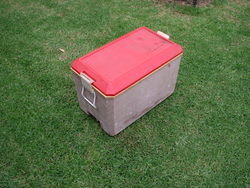
Haybox cooker - looking like a mild mannered esky
I first tried making a genuine hay box cooker many years ago out of straw, a pine box and a large glass casserole dish but it was not really successful. The main problem was that the casserole dish was too large so that you had to make too much food in one go, and there was not enough insulation between the casserole and the side of the wooden box. It was pretty pathetic and I gave up on the idea for a while.
It was Christmas 2002 and while wandering through a neighbour’s garage sale I spied a large plastic esky, it looked well used, but it was intact and BIG (590mm x 370mm x 420mm high), so for the princely sum of $5 it was mine! To turn it into a haybox cooker I then needed to work out what cooking pot/s to use what and insulation material to use.
Cooking Pots
I needed to work out the type of cooking pots to use. I had decided that the size of the esky would allow me to use two pots – a one litre and a two litre pot – so that I would have some flexibility depending on the number of people to be fed. The haybox cooker works most efficiently when the cooking pot is almost full of food.
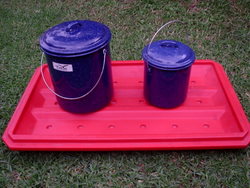
The pots I use
Another way to improve heat retention is to ensure that the cooking pots have the least possible surface area for the volume contained, this is a sphere – which is geometrically inconvenient for my purposes, so I settled on a couple of squat, enamelled steel billy cans. The lids of the cans also have a rim which ensures that condensation on the lid is returned to the pot.
The enamelling on both pots is a dark blue and the idea was that I could use my solar oven to heat up the food and then put it into the haybox cooker to complete the process. That was the theory and for the 1 litre pot it works fine, but I found that when I tried the 2 litre pot it is just a wee to big, and prevents the glass front from entirely closing, which in turn lets the heat out. Another fine theory blown to hell due to lack of attention to detail!
Insulation
The obvious answer here was “hay”, being a traditionalist of sorts, but hay has some disadvantages in that it is not so effective an insulator as some modern materials and it tends to absorb steam and odours during the cooking process which then cause it to grow bugs (yuch!). I wanted something that was light, low maintenance and an effective insulator. As luck would have it, a friend offered me an 1800mm x 900mm sheet of polystyrene foam that was 25mm thick and had been used as packing in a container, so I accepted it gratefully.
I still needed to cut it to shape and the classic way using a saw creates a hell of a mess with fine particles of polystyrene all over the place. So rather than do that I looked around to see if I could get hold of hot wire cutter, which makes a nice smooth cut with little or no little fiddly bits. After some searching I found a reasonably priced ($25) battery powered unit available from Hobbyco in the city (Sydney). Its limitation was that it could only cut polystyrene sheet up to 35mm thick so this was not much of a problem with my stuff being only 25mm thick.
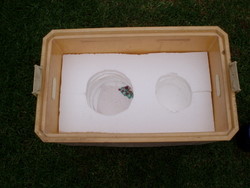
Looking in the box at the styrofoam insulation
I cut two slabs to act as the bottom insulation and then a number of strips with holes in them to accept the cooking containers up to the level of their lids. Here the analogy breaks down! To use the rigid polyester foam over the tops of the cooking containers by carving out the correct size and shape was beyond my technology, so I remembered our family motto - “when all else fails – cheat!”. I bought some polystyrene beads, used for stuffing bean bags and made up a cushion by loosely filling an old flannelette pillowcase, which sits neatly on top of the cooking containers and acts and an insulator. I sewed the pillowcase closed, because anything less than an airtight seal and the beans escape and get EVERYWHERE!
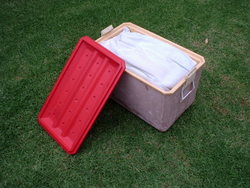
Open haybox showing insulating
One problem with the esky was that, in common with a lot of esky’s nowadays, there is actually no insulation in the formed plastic top, I assume that the air gap in the lid is supposed to act as an insulator. I was not happy with this, so using a cut off funnel I persuaded a whole stack of the polystyrene beans to go into a moulding hole in the top. That was one tedious job, because the beans clearly did not want to go into the lid! Anyway once completed I sealed the hole with an (unused) industrial ear plug.
The haybox cooker was now completed.
Operation
The idea is to load up the cooking pot with your food in the same way you would a crock pot, this style of cooking lends itself to soups, stews and casseroles ie wet cooking so if you are after dry or crisp, this is not the way to go. Having filled your pots with ingredients and water up to about 25mm from the top, put it on the stove and bring it up to the boil, and boil for five minutes to 10 minutes to get the heat into the centre of any larger lumps of ingredient. Once it has been boiling for 5 minutes quickly transfer it to the haybox cooker, smooth down the insulating pillow and clamp on the lid. Leave everything undisturbed for 8 to 12 hours (No peeking!) and then open for a hot deliciously cooked meal. For more detail on how I cook with our hay box cooker go here.
To test our haybox cooker, I filled both containers and boiled them, transferring them straight to the cooker and then sealed it up. Early the next day, about 10 hours later, the 2 litre pot was still over 90°C and the 1 litre one was still above 85°C. The haybox cooker has served us very well, particularly during winter and I even used it to make a batch of my beef and veggie soup, a family favourite. I still looks a bit basic and I want to make a nice wooden box to go around it so that it looks like a piece of furniture rather than a well used esky…………………..eventually!
Update 2013 - Unfortunately I never did get around to making a box for the outside of the cooker to make it a look more reputable, but I did make a whole new one based on a piece of reasonable looking furniture to start with. It gets used regularly and works very, very well!
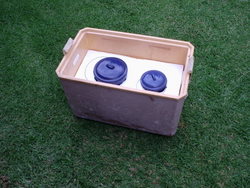
Copyright © 2019 underthechokotree.com. All Rights Reserved.
Joomla! is Free Software released under the GNU/GPL License.
Written by Nevin

Haybox cooker - looking like a mild mannered esky
I first tried making a genuine hay box cooker many years ago out of straw, a pine box and a large glass casserole dish but it was not really successful. The main problem was that the casserole dish was too large so that you had to make too much food in one go, and there was not enough insulation between the casserole and the side of the wooden box. It was pretty pathetic and I gave up on the idea for a while.
It was Christmas 2002 and while wandering through a neighbour’s garage sale I spied a large plastic esky, it looked well used, but it was intact and BIG (590mm x 370mm x 420mm high), so for the princely sum of $5 it was mine! To turn it into a haybox cooker I then needed to work out what cooking pot/s to use what and insulation material to use.
Cooking Pots
I needed to work out the type of cooking pots to use. I had decided that the size of the esky would allow me to use two pots – a one litre and a two litre pot – so that I would have some flexibility depending on the number of people to be fed. The haybox cooker works most efficiently when the cooking pot is almost full of food.

The pots I use
Another way to improve heat retention is to ensure that the cooking pots have the least possible surface area for the volume contained, this is a sphere – which is geometrically inconvenient for my purposes, so I settled on a couple of squat, enamelled steel billy cans. The lids of the cans also have a rim which ensures that condensation on the lid is returned to the pot.
The enamelling on both pots is a dark blue and the idea was that I could use my solar oven to heat up the food and then put it into the haybox cooker to complete the process. That was the theory and for the 1 litre pot it works fine, but I found that when I tried the 2 litre pot it is just a wee to big, and prevents the glass front from entirely closing, which in turn lets the heat out. Another fine theory blown to hell due to lack of attention to detail!
Insulation
The obvious answer here was “hay”, being a traditionalist of sorts, but hay has some disadvantages in that it is not so effective an insulator as some modern materials and it tends to absorb steam and odours during the cooking process which then cause it to grow bugs (yuch!). I wanted something that was light, low maintenance and an effective insulator. As luck would have it, a friend offered me an 1800mm x 900mm sheet of polystyrene foam that was 25mm thick and had been used as packing in a container, so I accepted it gratefully.
I still needed to cut it to shape and the classic way using a saw creates a hell of a mess with fine particles of polystyrene all over the place. So rather than do that I looked around to see if I could get hold of hot wire cutter, which makes a nice smooth cut with little or no little fiddly bits. After some searching I found a reasonably priced ($25) battery powered unit available from Hobbyco in the city (Sydney). Its limitation was that it could only cut polystyrene sheet up to 35mm thick so this was not much of a problem with my stuff being only 25mm thick.

Looking in the box at the styrofoam insulation
I cut two slabs to act as the bottom insulation and then a number of strips with holes in them to accept the cooking containers up to the level of their lids. Here the analogy breaks down! To use the rigid polyester foam over the tops of the cooking containers by carving out the correct size and shape was beyond my technology, so I remembered our family motto - “when all else fails – cheat!”. I bought some polystyrene beads, used for stuffing bean bags and made up a cushion by loosely filling an old flannelette pillowcase, which sits neatly on top of the cooking containers and acts and an insulator. I sewed the pillowcase closed, because anything less than an airtight seal and the beans escape and get EVERYWHERE!

Open haybox showing insulating
One problem with the esky was that, in common with a lot of esky’s nowadays, there is actually no insulation in the formed plastic top, I assume that the air gap in the lid is supposed to act as an insulator. I was not happy with this, so using a cut off funnel I persuaded a whole stack of the polystyrene beans to go into a moulding hole in the top. That was one tedious job, because the beans clearly did not want to go into the lid! Anyway once completed I sealed the hole with an (unused) industrial ear plug.
The haybox cooker was now completed.
Operation
The idea is to load up the cooking pot with your food in the same way you would a crock pot, this style of cooking lends itself to soups, stews and casseroles ie wet cooking so if you are after dry or crisp, this is not the way to go. Having filled your pots with ingredients and water up to about 25mm from the top, put it on the stove and bring it up to the boil, and boil for five minutes to 10 minutes to get the heat into the centre of any larger lumps of ingredient. Once it has been boiling for 5 minutes quickly transfer it to the haybox cooker, smooth down the insulating pillow and clamp on the lid. Leave everything undisturbed for 8 to 12 hours (No peeking!) and then open for a hot deliciously cooked meal. For more detail on how I cook with our hay box cooker go here.
To test our haybox cooker, I filled both containers and boiled them, transferring them straight to the cooker and then sealed it up. Early the next day, about 10 hours later, the 2 litre pot was still over 90°C and the 1 litre one was still above 85°C. The haybox cooker has served us very well, particularly during winter and I even used it to make a batch of my beef and veggie soup, a family favourite. I still looks a bit basic and I want to make a nice wooden box to go around it so that it looks like a piece of furniture rather than a well used esky…………………..eventually!
Update 2013 - Unfortunately I never did get around to making a box for the outside of the cooker to make it a look more reputable, but I did make a whole new one based on a piece of reasonable looking furniture to start with. It gets used regularly and works very, very well!

Copyright © 2019 underthechokotree.com. All Rights Reserved.
Joomla! is Free Software released under the GNU/GPL License.








